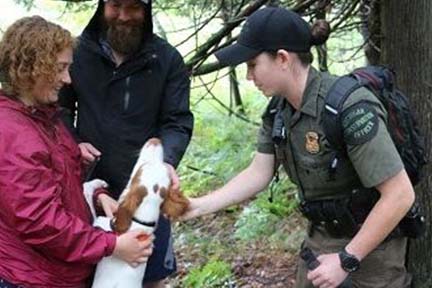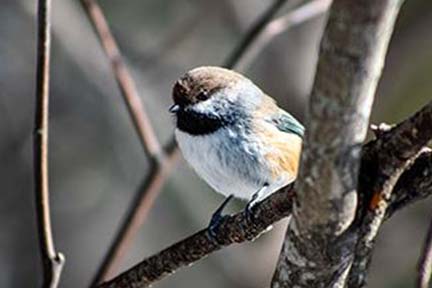| Here are a few of this week’s stories from the Michigan Department of Natural Resources:
See other news releases, Showcasing the DNR stories, photos and other resources at Michigan.gov/DNRPressRoom.
PHOTO FOLDER: Larger, higher-res versions of some of the images used in this email are available in this folder.
 If you’re planning a spring break trip to a warmer destination and intend to rent a personal watercraft (such as a Jet Ski) while there, don’t forget to take a copy of your Michigan boater safety certificate. If you’re planning a spring break trip to a warmer destination and intend to rent a personal watercraft (such as a Jet Ski) while there, don’t forget to take a copy of your Michigan boater safety certificate.
Safety certificates are proof that you’ve completed a program meant to teach the fundamentals of safety for your chosen activity. Many states require this documentation before allowing you to rent and/or operate a boat or personal watercraft. Misplaced your certificate? No worries; you can request a duplicate.
In Michigan, people born before July 1, 1996, may legally operate a boat without restrictions. Those born on or after July 1, 1996, may legally operate a motorized boat over 6 horsepower only if they have been issued a boating safety certificate and have it in their possession. Anyone born on or after Dec. 31, 1978, must have a boater safety certificate to legally operate a personal watercraft.
If you need a safety certificate, you can take recreational safety education courses online from the comfort of your home and at your own pace. Learn more at Michigan.gov/RecreationalSafety.
Questions? Email [email protected]. |
 What does your perfect outdoor day look like? What does your perfect outdoor day look like?
Maybe it includes a hammock, blue skies and a soft summer breeze rustling through the leaves of a shade tree. Perhaps you’re reading under a flowering tree in spring, or picking autumn apples right off the branches in your backyard.
We may be biased, but at the DNR we think the best days often involve trees! If you agree, take steps now to set the stage for perfect planting days this spring.
Get started today
The time to order your tree is now. Local conservation districts, nurseries and reputable online retailers are all good places to find the right tree for your space. Whether you’re looking for a tall, fast-growing shade tree or a small, flowering tree to attract bees and butterflies, it’s helpful to learn about the needs of the tree species you want to plant so you can help it grow.
If you want to plant many trees or need layout assistance, a landscaping or nursery professional can help with planning and logistics.
Tree tips and resources
Find how and where to plant a tree, suggestions for what kind of tree to plant and tips to care for your tree at Michigan.gov/MiTrees. You’ll also find a planting map where you can digitally “pin” your new tree and add it to a growing online forest that reflects the landscape. Each tree planted gets Michigan closer to our 1T.org pledge to plant 50 million trees by 2030.
With proper planting and care, your tree will grow strong and healthy. Questions about tree care? Contact DNR urban forester Lawrence Sobson at 313-316-4137. |
Each month, the DNR offers a variety of opportunities to help take care of Michigan’s natural and cultural resources. Here are a few ways to get involved in March.
State park stewardship
 Several state parks in southern Michigan will host stewardship workdays, where volunteers are needed to help remove invasive plants that threaten high-quality ecosystems. Several state parks in southern Michigan will host stewardship workdays, where volunteers are needed to help remove invasive plants that threaten high-quality ecosystems.
Workdays will take place:
- 10 a.m. to noon Saturday, March 2, at Warren Dunes State Park (Berrien County).
- 10 a.m. to 12:30 p.m. Sunday, March 3, at Muskegon State Park (Muskegon County).
- 10 a.m. to 12:30 p.m. Sunday, March 10, and Sunday, March 24, at Yankee Springs Recreation Area (Barry County).
- 10 a.m. to 12:30 p.m. Saturday, March 16, at Ludington State Park (Mason County).
- 10 a.m. to 12:30 p.m. Saturday March 23, at Fort Custer Recreation Area (Kalamazoo County).
Workday details and registration information can be found on the DNR volunteer events calendar. |
Fishing ‘Conversations and Coffee’
 If you’re interested in talking about fisheries management with us, mark your calendar for “Conversations and Coffee” events taking place this spring. If you’re interested in talking about fisheries management with us, mark your calendar for “Conversations and Coffee” events taking place this spring.
These virtual events – great opportunities to meet with DNR fisheries managers and biologists, discuss local issues and management activities, and get specific questions answered – are scheduled for:
- Northern Lake Michigan Management Unit: Tuesday, March 12, 7 to 8:30 p.m.
- Central Lake Michigan Management Unit: Wednesday, March 13, 5 to 7 p.m.
- Lake Superior Management Unit: Thursday, March 14, 6:30 to 8 p.m. EDT.
- Lake Erie Management Unit: Wednesday, April 3, 7 to 8:30 p.m.
- Lake Huron Management Unit: Wednesday, April 3, 6 to 7 p.m.
- Southern Lake Michigan Management Unit: Tuesday, April 9, 6:30 to 8 p.m.
Meeting links will be available soon. For more details, see the Conversations and Coffee webpage.
For more opportunities to lend a hand or provide input on all DNR programs, visit Michigan.gov/DNRVolunteers. |
The DNR offers a variety of opportunities next month to learn about and enjoy Michigan’s outdoors. Here are a few highlights! For the full, statewide list of events, see Michigan.gov/DNRCalendar.
Maple syrup making, steelhead fishing
 Want to try something new, brush up on skills or learn tips and tricks from the pros? The Outdoor Skills Academy can help, with expert instruction, gear and hands-on learning for a range of outdoor activities. Want to try something new, brush up on skills or learn tips and tricks from the pros? The Outdoor Skills Academy can help, with expert instruction, gear and hands-on learning for a range of outdoor activities.
Coming up at Mitchell State Park’s Carl T. Johnson Hunting and Fishing Center in Cadillac, you can learn about maple syrup making and steelhead fishing. The March 9 Maple Syrup Clinic covers tools needed, sap processing, canning, making the final product and more. And in the one-day Steelhead Fishing Seminar March 16 and two-day Steelhead Fishing Clinic March 23-24, the Outdoor Skills Academy pro-staff will present strategies and techniques for chasing Michigan’s “chrome torpedoes.”
Additional sessions of the steelhead classes are scheduled in April, along with turkey hunting, walleye fishing, and whitetail food plot and habitat management clinics. The rest of the year brings opportunities to learn about wild mushrooms, fly fishing, wilderness survival, bear and waterfowl hunting, processing and cooking venison, trapping and more.
See the full, evolving OSA schedule at Michigan.gov/OutdoorSkills. |
Birds, lumberjacks and more at OAC
 If you live in or will be traveling to southeast Michigan, don’t miss nature-related fun for all ages at the Outdoor Adventure Center in Detroit. If you live in or will be traveling to southeast Michigan, don’t miss nature-related fun for all ages at the Outdoor Adventure Center in Detroit.
OAC staff will lead birding programs at Belle Isle Park in Detroit March 10 and at Proud Lake Recreation Area in Oakland County March 24. Join in a fun night of archery and trivia during Grown-Up Gatherings: Archery March 15, or explore this pastime with several other March archery events.
Don’t miss the annual Lumberjack Pancake Run March 23 – wear your finest flannel apparel and sport your best lumberjack beard (prizes awarded to the best dressed!) – and get race swag including a custom medal, a lumberjack buff, Outdoor Adventure Center entry and a pancake breakfast. And check out Lumberjack Day following the run, with special forest-themed programs and activities.
There are also programs especially for seniors, kids, teachers, home-schooled students and others on the March OAC event calendar. |
 See more pictures by Michigan state parks photo ambassadors at Instagram.com/MiStateParks. For more on the program, call Stephanie Yancer at 989-274-6182. (This photo is by Ana Easlick, for the Michigan DNR, at Belle Isle Park on the Detroit River.) See more pictures by Michigan state parks photo ambassadors at Instagram.com/MiStateParks. For more on the program, call Stephanie Yancer at 989-274-6182. (This photo is by Ana Easlick, for the Michigan DNR, at Belle Isle Park on the Detroit River.)
|










